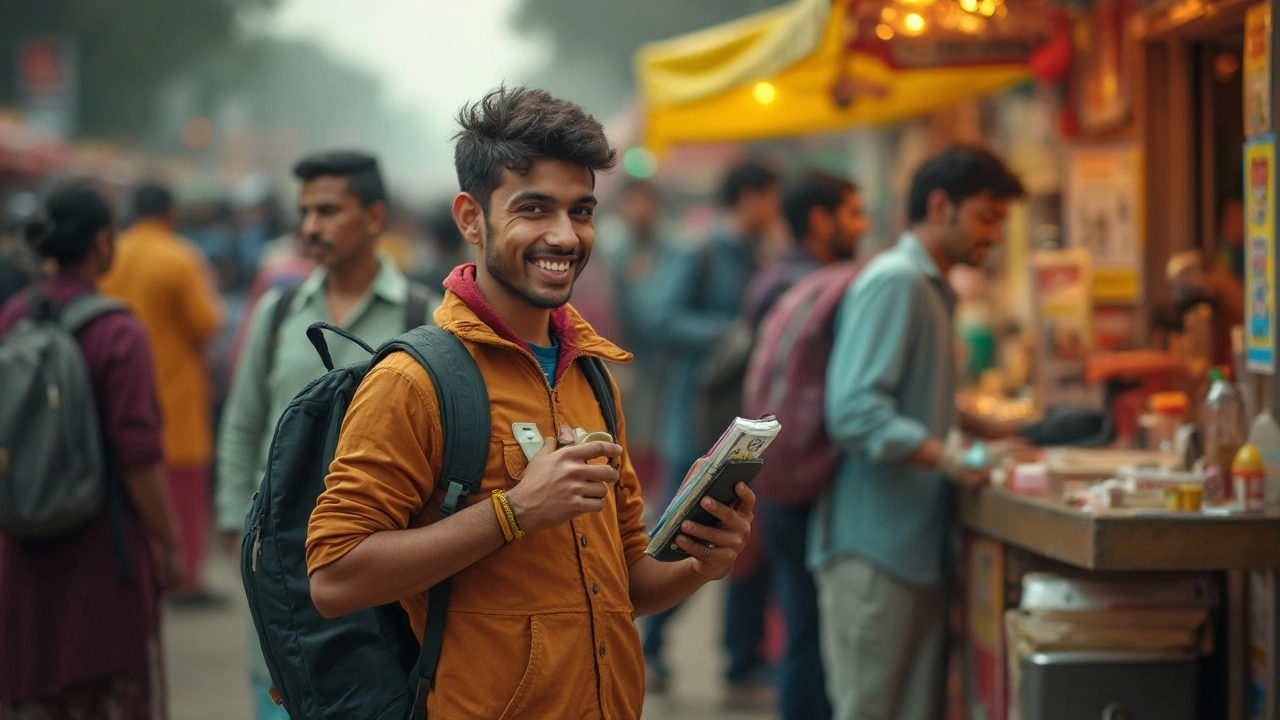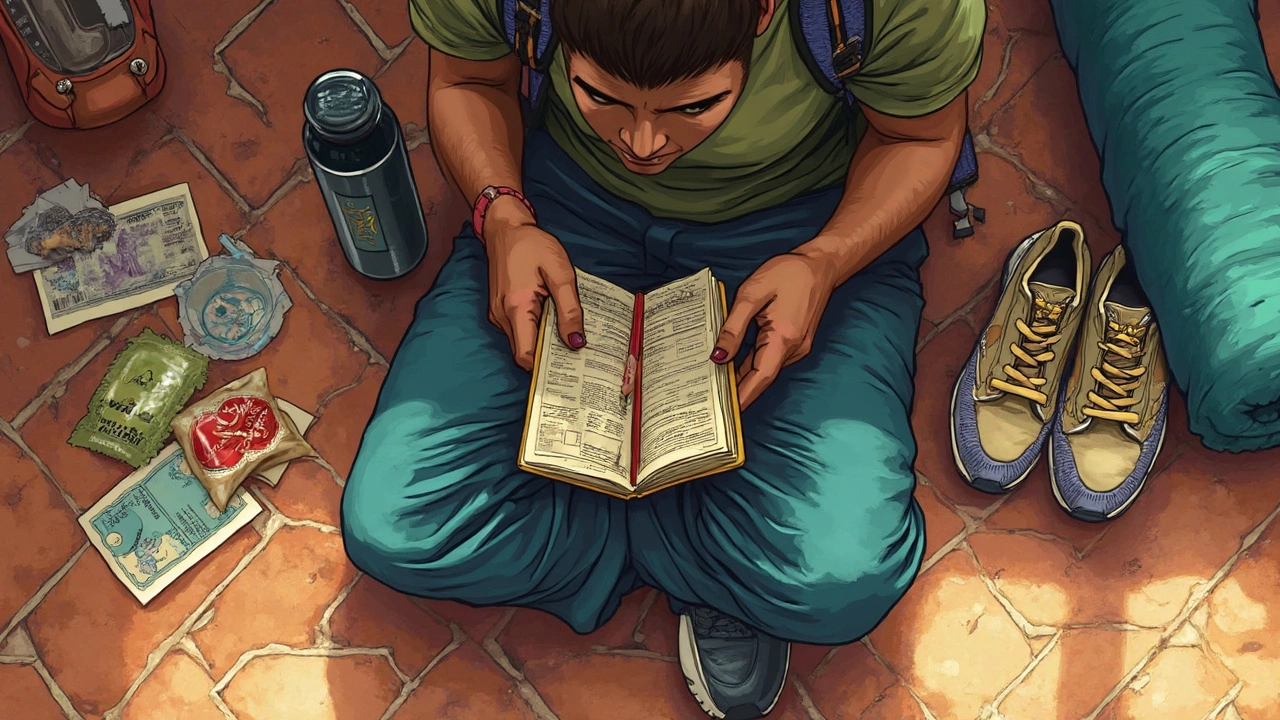Budget Travel India: How to Prepare the Smart Way
 May, 28 2025
May, 28 2025
India is somewhere between a backpacker’s dream and a reality check—massive, wild, and never boring. Thing is, you can't just rock up with a passport and hope for the best. The paperwork trips up more travelers than a sleeper train bump. Visas can get weird, and you’ll need travel insurance that actually covers more than lost flip-flops. Plus, don’t ignore the vaccine requirements; your stomach will thank you later.
Forget the idea of packing a closet. You’ll regret lugging too much. India is hot, cold, muddy, and dry—sometimes in the same day. Get a few lightweight shirts, a solid power bank, hand sanitizer (you’ll need it a hundred times a day), and a padlock for hostel lockers. Skip the jeans; they’re sweat traps. Leave the expensive tech at home unless you like stress.
- Getting Your Paperwork Right (Visas, Insurance, Vaccines)
- What to Pack (And What to Leave Behind)
- Money-Saving Hacks and Budget Planning
- Safety, Scams, and Street Smarts
Getting Your Paperwork Right (Visas, Insurance, Vaccines)
Most countries can get an Indian e-Visa online, but don’t wait until the last minute—processing usually takes at least 72 hours, and mistakes can delay it further. Go straight to the official government site (indianvisaonline.gov.in). Third-party sites may look legit but charge way more for the same thing. Triple-check the visa type: a tourist e-Visa is fine for sightseeing, but you’ll need something else for longer stays or volunteering.
Your passport needs to be valid for at least six months past your arrival date and have two blank pages for stamps. Print your visa approval and keep a copy on your phone; Indian officials love paperwork, and airport Wi-Fi is hit or miss.
Travel insurance isn’t just for peace of mind—it’s plain necessary. Hospital bills or lost gear can wipe out your budget fast. Look for a plan that covers medical emergencies, theft, and cancellations. World Nomads and SafetyWing are popular with backpackers. Always check the exclusions; adventure activities like trekking or scootering usually need extra coverage.
Vaccines might sound boring, but skipping them isn’t worth the risk. The basics for India are Hepatitis A and B, typhoid, and tetanus. Some doctors also recommend rabies or Japanese Encephalitis if you’re in rural areas or staying a long time. Double-check if you need a COVID-19 certificate or yellow fever shot (mainly if you’re coming from Africa or South America).
- Apply for the e-Visa on the official site, not a random agency.
- Make sure your passport is good for six more months at least.
- Print all visa-related documents before flying.
- Buy travel insurance that covers healthcare, not just cancellations.
- Handle your vaccines at least four weeks before your flight.
Sorting this stuff early means fewer headaches and more time for exploring. You don’t want paperwork to be the reason you miss your train to Varanasi.
What to Pack (And What to Leave Behind)
Your bag is your lifeline when you’re doing budget travel India, so keep it simple and practical. Anything bulky or fancy will probably end up as dead weight. Ever notice that most travelers wear the same T-shirt in every photo? There’s a reason: you only need a handful of clothes. Laundry’s everywhere and cheap.
Here’s a streamlined packing list for India, tried and battle-tested:
- 3-5 lightweight tops (cover your shoulders, especially for temples)
- 2 pairs of loose pants (skip jeans—humidity in places like Mumbai will make you regret them)
- 1 light jacket (it gets chilly up north or on night trains)
- Good walking shoes or sandals (streets can be rough on footwear)
- Flip-flops for showers and hostels
- Small first aid kit (add Imodium, rehydration salts, and bandaids)
- Toilet paper and wet wipes (not always available where you need them)
- Reusable water bottle with filter (tap water isn’t safe for travelers)
- Padlock for hostel lockers
- Hand sanitizer and mosquito repellent
- Universal adapter and power bank (power cuts happen)
Want to see what most travelers end up leaving behind or regretting? Here’s a look at what you can ditch without second thoughts:
- Heavy books—swap them for an e-reader or your phone
- Big toiletries—buy shampoo, toothpaste, etc., on the ground where it’s cheap and lighter
- Fancy jewelry or watches—too flashy, easier to lose
- Too many gadgets—a phone and charger are enough for most
- Thick jackets—unless you’re trekking in the Himalayas during winter, one layer is enough
If you’re worried about extreme weather or festivals like Holi (where everything gets colored powder on it), pick up cheap T-shirts in local markets. They’re cheap and made for Indian conditions.
| Item | Buy Before Arrival | Buy in India |
|---|---|---|
| Toiletries | No | Yes (cheaper, local brands) |
| Clothes | Some basics | Yes (for local weather, modesty) |
| Medicines (basic kit) | Yes | Possibly (pharmacies everywhere) |
| Mosquito Repellent | No | Yes (locally effective brands) |
| Adapter/Power Bank | Yes | Available, but brands may vary |
Pack for comfort, not for Instagram. You’ll blend in better, move faster, and avoid extra fees at the airport. If you forget something, Indian markets have you covered, usually for less than a cup of coffee back home.

Money-Saving Hacks and Budget Planning
Traveling around India on a shoestring budget isn’t just possible—it’s kind of the norm for backpackers. But where you really win (or lose) is in the daily choices. Here’s how to get more out of less, keep your wallet full, and still grab epic experiences.
The cost of living in India is wild if you’re used to Western prices. For example, a filling veggie meal at a local dhaba can cost as little as 60 rupees (less than $1), while a comfy budget guesthouse runs 500–800 rupees per night. Big cities are pricier, but smaller towns stretch your rupee way further.
| Expense | Average Daily Cost (INR) |
|---|---|
| Food (street/local) | 200–350 |
| Hostel Dorm | 500–900 |
| Local Transport | 150–250 |
| Bottled Water | 20–40 |
| Attractions/Entry Fees | 200–400 |
Want to keep your budget travel India experience on track? Here are proven hacks that actually work:
- Use government-run trains and buses. Booking via IRCTC saves cash (and you can secure sleeper class seats for cross-country journeys for less than ten bucks).
- Eat local. Ditch fancy cafés and grab simple thalis, dosas, or samosas from busy spots where locals eat. They’re both tasty and safe because high turnover means fresh food.
- Always ask for a metered fare in rickshaws and cabs. If they refuse, walk away or use an app like Uber or Ola, which is usually cheaper in cities.
- Share rides and split costs with fellow travelers, especially for tuk-tuk or taxi trips from the airport or train station.
- Bargain—but do it with a smile. In markets and for short rides, haggling is normal and expected. Start low and meet in the middle.
- Book tickets (trains, long-distance buses, or attractions) as early as possible. Last-minute bookings always cost more and popular sleeper-class tickets sell out fast.
- Use free WiFi in cafés, hotels, or train stations instead of buying a hefty data plan—though grabbing a cheap Indian SIM card for emergencies or navigation is a smart move.
- Watch for hidden costs—temple shoe lockers, bottled water, and camera entry fees add up. Carry small notes and coins because paying with large bills can attract unnecessary attention.
Here’s the golden rule: set a daily limit. It’s easy to lose track in chaos, so use a budget app (like Trail Wallet or Splitwise) and log everything. That way, you avoid “where did my money go?” at the end of your trip. Extra tip: always stash an emergency bill deep in your backpack—ATMs can be unpredictable outside major cities.
Safety, Scams, and Street Smarts
If you’re heading to India on a budget, looking after your cash and your safety goes hand-in-hand. Tourists are magnets for scams, but once you know what to look for, you’ll avoid most traps. The biggest thing: keep your cool, even when folks seem pushy. India’s chaos works in your favor if you can blend in and not act lost.
Let’s talk about some of the classic scams. The “closed hotel” scam is everywhere—your tuk-tuk driver tells you your hostel is closed and tries to take you to his friend’s place. Don’t fall for it. Always book your first night’s stay in advance and use Google Maps or the official booking app. Another common one: fake train ticket sellers at the station. Buy tickets only from official counters or the IRCTC website.
Here are a few street-smart moves to keep you out of trouble:
- Carry a padlock. Many budget hostels provide lockers but no locks.
- Use a money belt or keep cash split between bags.
- Act confident, even when you’re not sure where you are. Hesitation makes you a target.
- If someone offers to guide you somewhere, be cautious. Politely say no if you didn’t ask for help.
- Download offline maps. Internet drops out in random places, even in cities.
Pickpocketing isn’t as common as in some countries, but crowded buses or train stations are risk zones. Don’t flash cash, and keep your phone tucked away unless using it.
"India is safe for travelers, but common sense should never take a holiday. Trust your gut, and be polite but firm." — Lonely Planet India (2023 Guide)
Solo female travelers need a bit more caution. Long sleeves and loose clothing help you blend in and avoid unwanted attention. Stick to busy areas after dark and try to arrive in new cities during daylight.
When it comes to health and food safety, go with your eyes and nose. If the food stand looks super crowded with locals, that’s usually better than the fancy empty place. Drink only bottled or filtered water—never straight from the tap—and check the seal before you gulp.
Here’s some real-world safety data to put things in perspective:
| Safety Factor | India (reported 2024) |
|---|---|
| Violent Crime Rate (per 100K) | 35 |
| Pickpocket Reports (Major Cities) | Medium risk |
| Tourist-targeted Scams | Common near train stations, tourist hotspots |
| Foodborne Illness (traveler cases) | 20-30% of visitors experience minor issues |
The most important thing for budget travel India? Trust yourself, prepare ahead, and try not to stand out as a confused tourist. Most scams crumble when you act like you’ve done this before—even if you haven’t. It’s street smarts, not paranoia, that will keep your trip smooth and your wallet full.